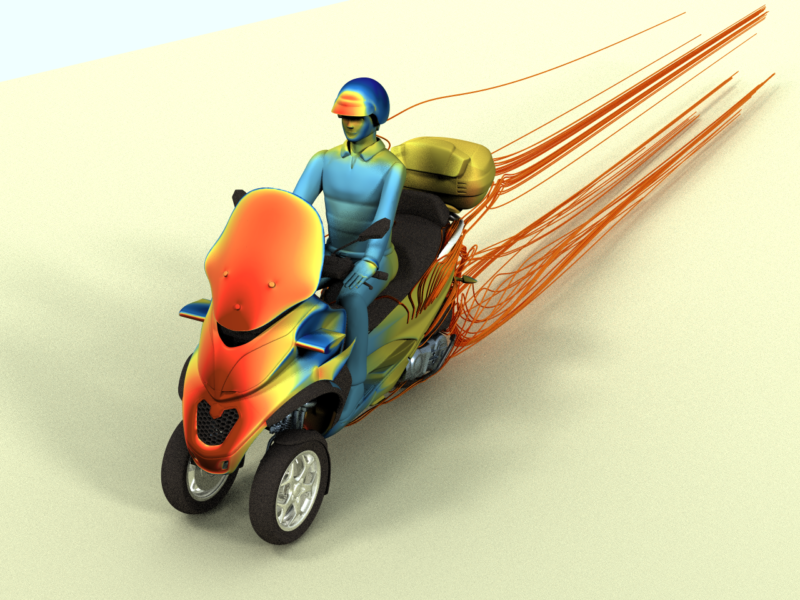The Challenge
Il progetto ADAMo – Aerodinamica Digitale Adattiva per Motocicli
The ADAMo project – Adaptive Digital Aerodynamics for Motorcycles – was born from the need to improve the aerodynamic behavior of two-wheeled vehicles under various operating conditions based on the adopted riding configuration. To implement this innovative idea, it is necessary to evaluate the potential of adaptive aerodynamic devices capable of providing the required performance based on certain key parameters, such as consumption, performance, safety, and comfort, depending on the operational conditions and the rider’s needs communicated to the system through a dedicated tool, such as a smartphone app.
The Idea
Cubit proposed a solution consisting of two main elements closely related to the company’s expertise:
- Develop the vehicle’s aerodynamic configuration using adaptive aerodynamics principles, of which Cubit is a pioneer with support for the development of the Ferrari FXX.
- Develop a mobile app together with a sophisticated adaptive aerodynamics control system that uses specific sensors, actuators, and internal and external communication networks.
Develop a mobile app together with a sophisticated adaptive aerodynamics control system that uses specific sensors, actuators, and internal and external communication networks.
The control system acts based on inputs provided by the rider through the app on the adaptive aerodynamic devices developed during the aerodynamic development. To do this proactively and not passively, two databases were created on which the controller operates:
- Characterization Database: It contains all the information on the vehicle’s aerodynamics and allows the system to evaluate the real-time usage conditions.
- Optimization Database: It identifies the appropriate corrective actions to achieve the rider’s desired objectives.
The project was developed on the architecture of the Piaggio Mp3 500 Production vehicle, considered the ideal candidate for performance implications in the usage segment and associated sales volumes.
M. Santucci e M. Pieve from Piaggio & C. S.p.A. collaborated for realizing this project.
Aerodynamic Development
Adaptive aerodynamics involves manipulating the airflow around a vehicle through the use of movable elements or local blowings and/or suctions in critical areas. Cubit’s expertise in this field originates from aeronautics, the native sector of active aerodynamics, and the project’s development of the experimental Ferrari FXX car, in which Cubit’s Technical Director, G. Lombardi, and CFD leader, M. Maganzi, participated.
The starting point was to translate the performance indices underlying the ADAMo project into measurable engineering quantities:
- Consumption: mainly related to Aerodynamic Resistance at sustained speeds
- Performance: the maximum achievable speed is directly limited by Aerodynamic Resistance, and the maximum acceleration is related to the Vertical Load developed by the vehicle
- Safety: mainly related to the Pitching Moment of the vehicle, determining the front’s safety, and the lateral stability achieved with Roll Moment and Lateral Force.
- Comfort: represented by how turbulent the flow that hits the rider during driving is and associated with the Maximum and Average Turbulence Levels near the rider.
All aerodynamic evaluations were carried out using the commercial software Star CCM+, utilizing Cubit’s cluster consisting of 9216 cores housed at the INFN facilities in Pisa.
Through steady and unsteady RANS simulations, various flow regimes were studied in terms of speed and direction, thus fully characterizing various configurations and devices, identifying their advantages and disadvantages:
- Blowing and Aspiration: The effectiveness of blowing in the vehicle’s wake and on the lateral hulls to reduce resistance and turbulence was evaluated; the results promise a 24% increase in the desired moment, and hence, the front’s safety.
- Front Movable Wings: This type of device is excellent for increasing all safety-related parameters, acting differentially on the two sides of the vehicle, also increasing vertical load by 7.5%
- Side Deflectors: They reduce perceived turbulence by 50% while increasing vertical aerodynamic load on the front axle. Stylistically, they fit perfectly with the front wings.
- Movable Windshield: Causes a significant increase in aerodynamic resistance but provides high comfort for the rider. Its use is closely related to the rider’s demands through the driving selector.

The Final Configuration
The developed vehicle uses Front Movable Wings and Deflectors, discarding other devices considered too complex to implement in a vehicle with limited dimensions and too sensitive to uncontrollable factors, such as the rider’s height. This configuration was meticulously characterized, creating the Aerodynamic Databases that form the basis of the implemented adaptive aerodynamics control system.
In various driving conditions, vehicle consumption was reduced by 2%, and safety significantly increased, with desired moments increasing up to 30%. Moreover, the rider’s perceived comfort is much higher thanks to a 30% reduction in the average turbulence level of the flow near the rider.
Partnerships: CUBIT, Piaggio & C. SpA, PSM, R.I.CO., Telcomms, INFN, Department of Information Engineering, with partial funding from the Tuscany Region.
Cubit’s role: Beneficiary.
Total funding to Cubit: €154,260.71, distributed as follows: year 2018: €125,763.76; year 2020: €28,496.95.


